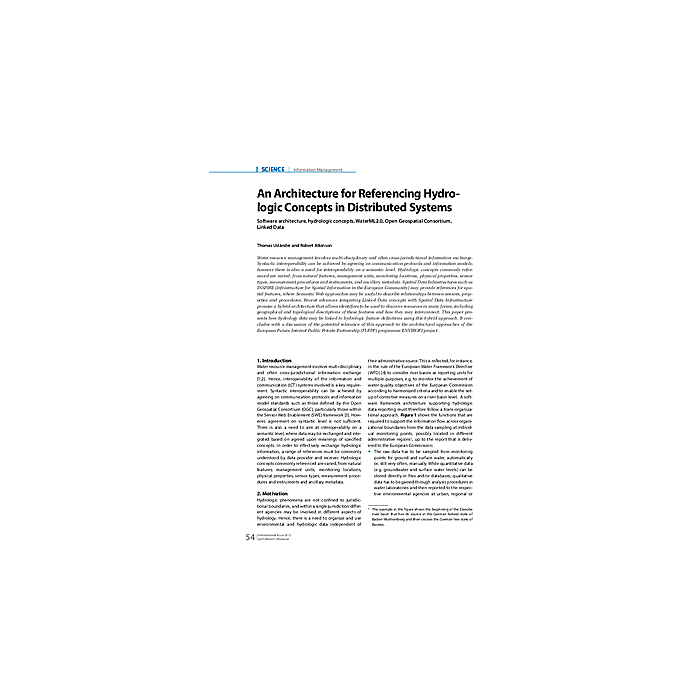An Architecture for Referencing Hydrologic Concepts in Distributed Systems
4,90 €
Auf Lager
Artikelnummer
05399_2012_SP1_05
Water resource management involves multi-disciplinary and often cross-jurisdictional information exchange. Syntactic interoperability can be achieved by agreeing on communication protocols and information models; however there is also a need for interoperability on a semantic level. Hydrologic concepts commonly referenced are varied, from natural features, management units, monitoring locations, physical properties, sensor types, measurement procedures and instruments, and ancillary metadata. Spatial Data Infrastructures such as INSPIRE (Infrastructure for Spatial Information in the European Community) may provide references for spatial features, where Semantic Web approaches may be useful to describe relationships between sensors, properties and procedures. Recent advances integrating Linked Data concepts with Spatial Data Infrastructure promise a hybrid architecture that allows identifiers to be used to discover resources in many forms, including geographical and topological descriptions of these features and how they may interconnect. This paper presents how hydrology data may be linked to hydrologic feature definitions using this hybrid approach. It concludes with a discussion of the potential relevance of this approach to the architectural approaches of the European Future Internet Public Private Partnership (FI-PPP) programme ENVIROFI project.
| Autoren | Thomas Usländer and Robert Atkinson |
|---|---|
| Erscheinungsdatum | 30.06.2012 |
| Format | |
| Zeitschrift | gwf - Wasser|Abwasser - Special 1 2012 |
| Verlag | DIV Deutscher Industrieverlag GmbH |
| Sprache | English |
| Seitenzahl | 4 |
| Titel | An Architecture for Referencing Hydrologic Concepts in Distributed Systems |
| Beschreibung | Water resource management involves multi-disciplinary and often cross-jurisdictional information exchange. Syntactic interoperability can be achieved by agreeing on communication protocols and information models; however there is also a need for interoperability on a semantic level. Hydrologic concepts commonly referenced are varied, from natural features, management units, monitoring locations, physical properties, sensor types, measurement procedures and instruments, and ancillary metadata. Spatial Data Infrastructures such as INSPIRE (Infrastructure for Spatial Information in the European Community) may provide references for spatial features, where Semantic Web approaches may be useful to describe relationships between sensors, properties and procedures. Recent advances integrating Linked Data concepts with Spatial Data Infrastructure promise a hybrid architecture that allows identifiers to be used to discover resources in many forms, including geographical and topological descriptions of these features and how they may interconnect. This paper presents how hydrology data may be linked to hydrologic feature definitions using this hybrid approach. It concludes with a discussion of the potential relevance of this approach to the architectural approaches of the European Future Internet Public Private Partnership (FI-PPP) programme ENVIROFI project. |
Eigene Bewertung schreiben


